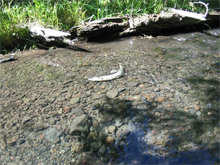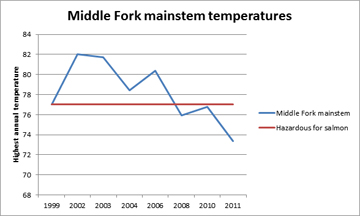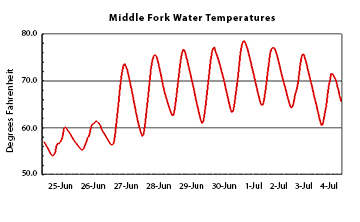
Oct. 2013: Research on 2009-2013 stream conditions in this important salmon habitat in the John Day River "highlights the potential for restoration to mitigate some of the effects of climate change. . .and spreading non-native species," says a manuscript recently accepted for publication in the research journal of the Ecological Society of America. Read more.
August 2013: A July spike in water temperatures that killed nearly 200 wild spring Chinook salmon on a remote stretch of the Middle Fork of the John Day River was tragic, but the way it happened highlights the importance of continuing projects by the Confederated Tribes of Warm Springs and others to restore habitat on the river, biologists say.
Biologists found the dead fish in a pattern that suggests that water temperatures were less severe in areas where habitat rehabilitation projects have restored deeper channels and riparian vegetation in recent years, said Jeff Neal, the Oregon Department of Fish and Wildlife’s district fish biologist in John Day. Fewer fish were found in areas below the restored areas, indicating that fish in those areas may have found refuge in cooler water.
“As a result of some of the channel work that was done three years ago on the main Middle Fork, the water cools down,” he said. “The deeper water is less exposed to solar heating.”
Fish kills were more common on the Middle Fork in the 1980s and 1990s, when exposed water rose to unsafe temperatures for fish almost every year, Neal said. But they have been less frequent since habitat projects began installing fences to protect riparian zones, improving the depth and path of channels and adding woody materials to provide shelter for fish. In the last decade fish kills have occurred only three times: 2003, 2007 and this year.
“That trend speaks very well of the work that has been done,” Neal said. “As a result of treating eight miles of the Middle Fork, the water cools down better than it used to but 11 more stream miles require channel improvements before this threat to salmon is eliminated.”
Parts of the Middle Fork were historically diverted and straightened into wide channels with little vegetation to shade water, leaving it to heat up in the summer sun. Temperatures can become lethal for salmon above about 77 degrees Fahrenheit. Much of the habitat work on the Middle Fork has been designed to restore more natural conditions that help moderate stream temperatures.
The Warm Springs Tribes have completed many of the habitat projects with BPA funding and have installed monitors to track the water temperatures. The most recent annual report of temperature trends reported that gauges in the Oxbow Conservation Area, a major focus of restoration, have shown lower overall water temperatures and maximum temperatures in recent years.

Annual maximum temperatures at the lower boundary of the Oxbow Conservation Area on the Middle Fork of the John Day River, where the Warm Springs Tribes have completed multiple restoration projects. Since water temperature depends on variables that fluctuate from year to year, graph shows general trends over time.
Data from 2011 Temperature Annual Report by the Confederated Tribes of the Warm Springs Reservation. Some years are absent because of missing data.
Returning the river to a naturally meandering channel allows water to percolate through the ground, cooling some of the water and raising the water table, which helps support trees and plants that shade the river, said Mark Croghan, subbasin liaison for the U.S. Bureau of Reclamation in the John Day River Basin.
“We’re trying to get riparian vegetation restored and all these things will help,” added Brian Cochran, a restoration ecologist who manages restoration projects for the Warm Springs Tribes. He said it is too soon to draw specific conclusions about how much restoration has affected water temperatures, but that the benefits should become clearer as the habitat work continues.
Temperature monitors in the Forrest Conservation area, another Warm Springs restoration site, also found declining water temperatures and maximum temperatures occurring later in the season. A similar gauge lower in the mainstem of the Middle Fork also showed that temperatures in recent years have peaked later, with lower maximum temperatures.
“The Middle Fork’s lack of riparian vegetation combined with a wide and shallow channel exposes so much of it to direct sunlight that temperature spikes will continue to occur here until we are able to narrow the channel, deepen the pools and grow more trees along it and its tributaries,” Neal said.
Biologists found few dead fish in and below the Oxbow Conservation Area, but more of them farther away from the restored section, Neal said. That indicates that temperatures there may have been less severe. He said he is concerned that some might see the fish kill as a sign that habitat improvement does not work, when it actually highlights the need for more.
The Middle Fork of the John Day is an Intensively Monitored Watershed, an area where scientists closely track the results of habitat restoration to better understand the benefits it provides. The temperature monitoring is part of the IMW studies. The results should help improve the effectiveness of habitat work and focus efforts where they will do the most good for fish.

Salmon are especially vulnerable when temperatures rise quickly, Neal said. In late June water temperatures in the Middle Fork rose from 62 degrees to 74 degrees in a day and then climbed to more than 78 degrees by July 1. (See chart at left.) IMW staff began discovering dead salmon the following day and biologists estimated altogether that 183 fish died, which could represent as much as 60 percent of all adult Chinook salmon in the Middle Fork, Neal said.
Additional projects scheduled in the Oxbow Conservation Area in 2014 will continue to improve the river channel, he said, which should continue the positive trends.